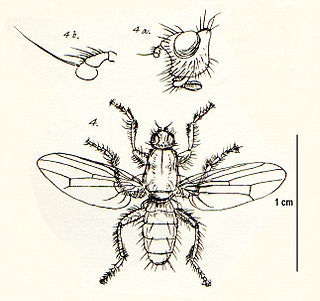
The Coelopidae or kelp flies are a family of Acalyptratae flies, they are sometimes also called seaweed flies, although both terms are used for a number of seashore Diptera. Fewer than 40 species occur worldwide. The family is found in temperate areas, with species occurring in the southern Afrotropical, Holarctic, and Australasian regions.

The Helosciomyzidae are a small family of flies found exclusively in the Southern Hemisphere. With the exception of the South American genus Sciogriphoneura, helosciomyzids occur only in Australia and New Zealand.

The Helcomyzidae are a small family of flies in the Acalyptratae. The larvae feed on kelp and other organic matter washed up on shorelines. Species diversity is highest in New Zealand and south temperate South America. They are sometimes allied with the families Dryomyzidae or Coelopidae.

Chaetocoelopa littoralis, commonly known as the hairy kelp fly, is a fly of the family Coelopidae. It is endemic to New Zealand and is widely distributed around the coastline, including offshore islands. These flies are black in appearance and show large variation in size, with males tending to be larger and more robust and 'hairy' than females.

This is a genus of kelp fly in the family Coelopidae. As of 2017, it is monotypic, consisting of its type species This canus. This and T. canus were respectively circumscribed and described in 1991 by the Australian entomologist David K. McAlpine. It is endemic to southern Australia.

Coelopa is a genus of kelp flies in the family Coelopidae. There are about 14 described species in Coelopa.
Gluma is a genus of kelp flies in the family Coelopidae.
Dasycoelopa is a genus of kelp flies in the family Coelopidae.
Coelopina is a genus of kelp flies in the family Coelopidae.

Chaetocoelopa is a genus of kelp flies in the family Coelopidae.
Rhis is a genus of kelp fly in the family Coelopidae.
Lopa is a genus of kelp flies in the family Coelopidae.
Amma is a genus of kelp fly in the family Coelopidae.
Beaopterus is a genus of kelp fly in the family Coelopidae.

Icaridion is a genus of kelp fly in the family Coelopidae.
Coelopella is a genus of kelp flies in the family Coelopidae.
Glumini is a tribe of kelp flies in the family Coelopidae.
Coelopini is a tribe of kelp flies in the family Coelopidae.
Coelopinae is a subfamily of kelp flies in the family Coelopidae.
Lopinae is a subfamily of kelp flies in the family Coelopidae.







